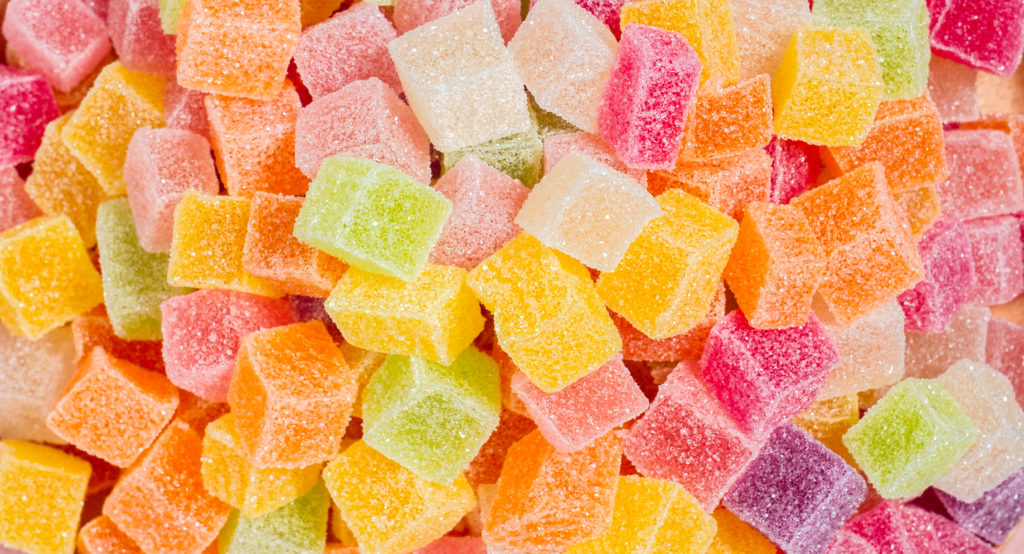Consumers are worried about sugar, but that isn’t stopping them from buying confectionery. Joseph Lee looks at what shoppers now look for in their sweets – and sours.
With health concerns about sugar rising, it might seem like the writing is on the wall for sweets. As Mark Roberts, trade marketing manager at Perfetti Van Melle, puts it: “Sugar is high on the agenda, with studies showing that 90% of consumers are trying to reduce the amount of sugar they buy, so it’s important to acknowledge this in your confectionery fixture.”
But growing awareness of sugar and a desire to reduce consumption isn’t translating into lower sales – sugar confectionery is doing better than ever, with the market worth almost £1.3bn and research suggesting that it’s likely to grow by 8.6% by 2019.
Two factors could explain why sugar confectionery sales remain so robust. The first is that manufacturers are responding to new challenges and changing consumer demand with new low- and no-sugar products. The second is that sugar confectionery remains an impulse treat. Even if shoppers are trying to cut overall consumption, they’re still likely to indulge themselves with confectionery.
“The sugar confectionery category is one of the biggest opportunities to drive sales in retail,” says Susan Nash, trade communications manager at Mondelez International. “Confectionery is not only worth a significant value in convenience, it is also the most impulsive category, meaning it can really help you drive sales – in particular, incremental sales.”
Tackling health concerns
There are few manufacturers who aren’t investing time and money in responding to fears about sugar’s role in the obesity crisis.
The task for many of them is to offer lower sugar options without compromising on the flavour. Take Rowntree’s, for example, which has just launched versions of Fruit Pastilles and Randoms with 30% less sugar – Rowntree’s parent company Nestlé says it took more than two years of research, 76 recipes and positive feedback from 9,000 taste-testers before it was ready to launch the healthier product.
The emphasis is on options for shoppers: manufacturers say they want to respond to public concerns by offering more choice: “The category faces continual pressure due to increasing focus on the nation’s health agenda and, in particular, sugar as a nutrient. In addition, consumer habits are changing, and they are more conscious about what they eat and the amount of sugar they consume,” says Jemma Handley, senior brand manager for Rowntree’s.
“Shoppers are looking to be in control of making their own choices and look to the sugar confectionery category to provide sufficient choice at the point of purchase – as well as leaving them informed enough to make the right choice for them.”
It’s a similar story at Perfetti Van Melle, which has added sugar-free and reduced-sugar variants to its range of Fruitella Gums and Foams.
“Sugar-free products need to be showcased and highlighted rather than dispersed around the range,” says Perfetti’s Roberts. “Signposting and clustering can help shoppers understand the range and make well-informed decisions.”
Some manufacturers are already claiming commercial success with sugar-free products. Wrigley’s Doublemint sugar-free mints bottle has notched up £1.8m of sales since its launch last year. “The launch is set to put the UK mints category into growth,” says Dan Newell, the company’s confections marketing manager.
Even niche products seem able to sustain sugar-free variants in this market, with Truede launching a sugar-free Turkish delight. Zeynep Turudi, the company’s founder, says that natural ingredients can provide alternatives to processed sugars.
“Consumers want to reduce their sugar intake but indulge their sweet tooth, without compromising on taste or quality,” she says. “That’s why natural ingredients are trending – and there are other plus points, such as no artificial colours or flavours.”
How to choose your range
With low-sugar products having upended the category, it’s a good time to take another look at your range of confectionery.
For Perfetti’s Roberts, that’s a good idea at any time, as novelty is a crucial factor in this category. “New products are vital in driving category growth as they encourage trading up,” he says. “So, keep up-to-date with what’s changing in the category by contacting your suppliers and reading the trade press.”
Among the big trends are new fruit flavours, with manufacturers saying that tropical, berry and sour flavours are among the big hits with consumers at the moment. Skittles has added 19% incremental sales with a tropical flavour, while new variants of Starburst, including the latest Very Berry flavour, have added 89% incremental sales. Very Berry is expected to total £4m of sales out of £18.5m in overall brand sales.
In February, Maynards Bassetts launched Wine Gums Tangy in an effort to introduce more adults to the appeal of sour candies. Sour flavours have already become a craze among children, with brands such as Brain Licker and Toxic Waste emphasising their extreme taste.
Refreshing fruit flavours such as these also get a seasonal boost, so suppliers suggest increasing stock during spring and summer – a time when chocolate sales can be more sluggish.
“Fruity sweets always fly off the shelves in spring and summer,” says Ross Stanley, head of trade marketing at Big Bear Confectionery. “So we expect to see an uplift in sales of our Fox’s Glacier Fruits during this time and we will be running summer promotions due to this.”
Last summer, Maynards Bassetts launched Juicy Chews, an adult sweet with a liquid centre intended to offer a more refreshing product.
Wrigley’s Newell says it’s also important to notice the impact of new formats – bottles have risen to become the most important formats for impulse buys.
Despite all the focus on new products, don’t forget familiar bestsellers. The mint category, for instance, continues to be dominated by Trebor, with £50m sales from a total of £147m for the category. Extra Strong Mints, launched in 1935, are the biggest seller.

Giving shoppers value for money
In a category where impulse purchases are so significant, it pays to keep an eye on prices. Manufacturers say that having pricemarked packs (PMPs) can make a big difference to sales.
Paul Simpson is UK commercial director of Bebeto, a supplier known for its jelly sweets. He says price points are even more crucial for confectionery aimed at younger children. “Demand for value for money is big, especially at the pocket money £1 and 50p price points,” he says. “Wholesalers should look to maximise sales of £1 lines.”
Other manufacturers agree with him. “We know price sensitivity is still a huge factor in customers’ decisions in-store,” says Big Bear’s Ross Stanley. “PMPs remain important across all our products, including the Fox’s Glacier range, as they offer a point of difference for independent retailers and give consumers reassurance that they are getting great value.”
According to Perfetti Van Melle, 50% of shoppers feel that PMPs indicate they’re getting the best value for money, encouraging impulse buys. Its £1 bags are growing at nearly 30% on last year’s sales.
“Retailers should therefore make sure PMPs are easy to see and that they are stocked in prominent places where impulse shoppers can take advantage of them,” says Perfetti’s Roberts. “Wholesalers can offer advice on merchandising that extends beyond placing key products by the till.”
For example, retailers could try positioning £1 packs of Smint by their coffee machines, so customers can freshen up after a hot drink, or including Fruittella sharing bags in any Big Night In display.
Sharing is caring
It might seem odd at a time when shoppers are supposed to be concerned about sugar consumption, but small packs are out and larger packs are in. Manufacturers say that sales of singles have fallen in candy and gum, but they suggest that wholesalers and retailers can easily make up the loss with sharing bags. Making confectionery into a social event may help make it seem less of a guilty pleasure to shoppers.
“Singles sales are down across both candy and gum, due to the removal of confectionery at checkout points and the growing competition from substitute products, resulting in a loss of £30m,” says Perfetti’s Roberts.
“Bags are by far the biggest growth opportunity for retailers. Shoppers are beginning to favour sharing formats, with the bags market currently worth £613m and growing at 1%.”
According to Roberts, 56% of sales by value are from bags, with brands such as Fruittella growing at 95% in the past year.
Wrigley’s Newell says that the Big Night In trend is helping to boost the format, with shoppers picking up bags of confectionery as part of their treats for a movie night at home, instead of going out.
Around half of consumers are spending less money on out-of-home entertainment and are eating out less, making treats at home more important than ever, Newell suggests. Most Skittles purchases (60%) are now for evening snacks.
“Creating a clear display that communicates the Big Night In occasion draws shoppers into the fixture and cross-category promotions will certainly encourage incremental purchases,” he says. “Remember to focus the display on products that are ideal for sharing, such as Starburst ‘tear and share’ pouches, which are individually wrapped and offer a variety of flavours for everyone to enjoy.”
A third of all confectionery sales are made on impulse, according to Perfetti, so helping retailers capitalise on spur-of-the-moment decisions is crucial for maximising confectionery sales. “33% of confectionery sales are pure impulse, so retailers must make sure these products are placed in high-visibility areas of the store,” says Roberts. “The category offers a huge opportunity for retailers wanting to encourage higher basket spend. Sugar confectionery remains one of the top four purchases in convenience, only ranking behind the everyday essentials of bread, milk and soft drinks.”
New formats are also helping to support impulse purchases, with bottles providing a convenient on-the-go alternative to bags, allowing shoppers to easily open and reseal the pack so they can exercise portion control and enjoy confectionery throughout the day and even in the car. They now represent 55% of impulse purchases, according to Wrigley.
Bebeto’s Simpson says wholesalers need to “educate, enlighten and enthuse” retailers by passing on category advice, and making sure this is clear and consistent. And he says retailers are just as likely to make impulse buys in-depot, therefore rendering it important to signpost confectionery and have the right case sizes in shelf-ready packaging to help the category stand out.
Placing confectionery in other parts of the depot, linking with related products around themes such as the Big Night In, can also help to drive unplanned purchases, he suggests.
Retailer viewpoints
“There are new lines coming through – things like Brain Lickers, and little drums called Toxic Waste. Sour things seem to be doing really well. To be honest, I don’t see sugar concerns affecting people where we are. I think sales of bags of sugar have gone down, but when it comes to bags of confectionery, our sales are as good as they’ve ever been, if not better.
“We’ve got two schools near us, we’ve got families with younger kids and we sell a lot of kiddie sweets, lollipops, small candies. The older lines that we remember as kids, they’ve  definitely slowed down, things like sherbet fountains, the Dip Dab. Wham bars still do well, the chew bars. But the things we remember when we were growing up, sales have slowed.”
definitely slowed down, things like sherbet fountains, the Dip Dab. Wham bars still do well, the chew bars. But the things we remember when we were growing up, sales have slowed.”
Harj Gill, The Windmill, Rubery, Birmingham
“We’re just about to go into a Mr Simms-type operation – they’re a chain of franchises thatdo the old jars of sweets. We’re going to do our own brand: Farrants Original. With all this fuss about sugar, you’d think the last thing you’d want to go into would be sugar  confectionery. But the nostalgia makes it seem more of a wholesome treat. That’s where the growth is. We’ll have jars at the counter, but the actual product will be underneath in bags. So we won’t weigh the product out – we’re trying to cheat really!”
confectionery. But the nostalgia makes it seem more of a wholesome treat. That’s where the growth is. We’ll have jars at the counter, but the actual product will be underneath in bags. So we won’t weigh the product out – we’re trying to cheat really!”
David Worsfold, Farrants Newsagents, Cobham, Surrey












I really liked what you said about the big trends for candies are new fruit flavors. My cousin owns a small candy store and is looking to refine his candy selection for the bulk bins. Thank you for the information about how manufacturers are saying that tropical, berry, and sour flavors are among the big hits with consumers.